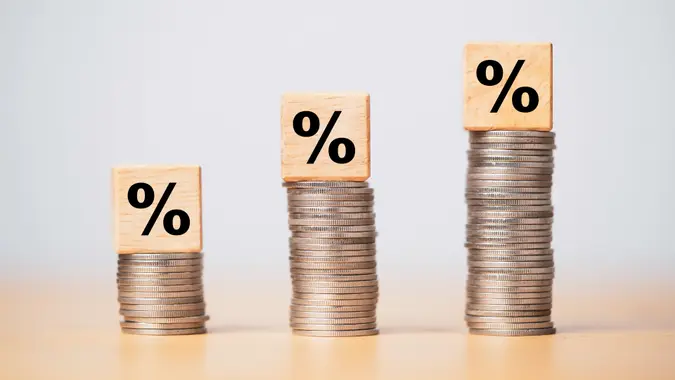How Much Interest $10,000 Earns in a Year

Commitment to Our Readers
GOBankingRates' editorial team is committed to bringing you unbiased reviews and information. We use data-driven methodologies to evaluate financial products and services - our reviews and ratings are not influenced by advertisers. You can read more about our editorial guidelines and our products and services review methodology.

20 Years
Helping You Live Richer

Reviewed
by Experts

Trusted by
Millions of Readers
Perhaps you recently moved $10,000 out of the stock market or away from an underperforming investment, or maybe you tucked that money into an emergency fund. Either way, you need that money to keep earning more for you.
Consider putting that $10,000 in an interest-paying account. How much you earn depends on the financial asset and institution that you choose. There are four financial assets to consider when determining how much interest $10,000 can earn in one year: certificates of deposit, high-yield savings accounts and money market accounts.
What Determines How Much Interest $10,000 Can Earn?
Three factors play a role in how much interest you can earn, especially with $10,000 set aside. These are your APY, the frequency at which your funds compound on that interest and the account type you have. Here’s a closer look.
The Role of APY
APY stands for Annual Percentage Yield, which is the amount of interest you can expect to make in one year. This includes any interest compounded on top of what you already have in the account. The higher the APY, the better your chances of earning more on the account are. You might want to look at different types of accounts to see the highest APYs available for the account you’d like to have.
Compounding Frequency
This refers to how often your interest compounds. This can be daily, monthly or yearly–all of which stack onto your funds. If your account allows for daily compounding, that means your account is earning interest a bit more frequently than monthly or yearly. A high-yield savings account or a money market account are examples of savings accounts that you’ll see offer daily compounding interest.
Account Type Matters
As noted earlier, the type of account you have also plays a role in how much you could earn. Here’s a quick view of some of the most common and accessible money-saving options.
- Savings accounts are usually the easiest and quickest to access, and interest rates tend to remain steady, though might not offer the highest APYs.
- Money market accounts can tend to have higher APY rates than savings accounts. Many have the features of both a savings and a checking account.
- High-yield savings accounts tend to have some of the best rates possible than their traditional savings counterparts, though, they can fluctuate depending on how the market is performing.
- CDs or certificates of deposit offer a fixed rate of interest, so you have a guaranteed return once the term matures. You’re also locked in for that set period–six months, one year, etc. whichever account you decide on.
How Much Interest Does $10,000 Earn in a Year in a Savings Account?
If you put $10,000 into a high-yield savings account, you can earn from $435 to $527 in a year — assuming your variable high-yield savings rate remains above 3.00%. Several banks are offering rates between 4.35% to 5.27% APY at this time.
According to FDIC, as of Feb. 18, 2025, the average rate on a savings account is 0.41%, which is lower than rates seen with high-yield savings noted above.
How Much Does $10,000 Earn in Other Savings Types?
If you have $10,000 to leave in a CD or money market account this year and interest rates remain high — 3.00% to 6.89% annual percentage yield — you can earn from $300 to almost $700 in interest over the next 12 months. Here’s a look at the current interest rates of these assets.
Money Market Accounts: A Flexible Alternative
Money market accounts are earning slightly less than high-yield savings accounts. However, some currently have an interest rate from 3.25% up to 5.46%. So, your $10,000 can earn as much as $325 to $546 in interest this year.
CDs: A Locked-In Option for Higher Rates
Many financial institutions are currently offering attractive CD rates. If you invest $10,000 in a 1-year CD, you can earn between 4.15% and 5.00% — the equivalent of $415 to $500 — depending on the bank or credit union.
The advantage of CDs is that your APY is guaranteed for a fixed term — unlike with other accounts and bonds, which change their rates as the fed rate rises and falls.
Monthly Earnings: How Much Does $10,000 Earn in a Month?
Knowing how your interest is calculated is fairly straightforward. It depends on the type of savings account you have and of course, how the interest is calculated. As noted earlier, the three primary factors that go into this calculation are: your APY, compounding frequency and account type.
How To Calculate Monthly Interest
Here’s the step-by-step breakdown so you can see how monthly interest is calculated.
- Your principal: In this example, it’s $10,000.
- Your APY rate: This is the interest rate on your account, and is compounded.
- Compounding frequency: The more frequently your account compounds, the more you can earn.
Calculating Simple Interest
You can use this formula to calculate simple monthly interest:
Monthly Interest = (APY/12) x Principal
If you had an account with 3.00% APY, for example, you would have (.03 / 12) x 10,000, which equals 25. That means you’d receive $25 each month from $10,000.
Compounding Interest
If you have an account that compounds daily–many high-yield savings accounts do–that means your interest is compounded each day. So you could stand to earn even more than the $25 in the example above.
Here are more examples based on a savings type with an estimated APY. This uses the simple calculation above. Remember that with compounding, you may earn a bit more than the simple interest calculation.
- Traditional savings account at 0.50% APY: ~$4 each month
- Money market account at 3.00% APY: ~$25 each month
- High-yield savings account at 4.50% APY: ~$37.50 each month
- CD account with 5.00% APY: ~$41.67 each month
Takeaway
The good news is that you have several options for earning at least 3.00% in interest. You’ll have easier access to your funds with a money market or high-yield savings account, but you’ll typically earn less than if you put your money into a CD, for example. Before choosing a financial asset or institution, consider fees, withdrawal limitations, penalties and interest rates.
Earning $10,000 in Interest FAQ
Here are answers to some of your most frequently asked questions about earning interest on $10,000 and beyond.- How much interest does $10,000 earn in a year?
- Earning $10,000 in interest will depend on the interest rate offered on the account, as well as the type of account you have. To earn more, try to choose an account with the highest APY and one that suits your financial situation. For example, a high-yield savings account is flexible in how much you can withdraw and tends to offer some of the best rates.
- What is the best account type for $10,000?
- The best type of account to earn $10,000 in interest depends on what suits your needs most. A high-yield savings account or similarly, a money market account, might fit the bill because these tend to offer fairly competitive interest. You could also look at a CD, as you can find many with high APY offerings as well, and the interest rate is fixed. You’ll need to lock in your funds for the length of the term.
- How does compounding frequency impact interest?
- The more your account compounds interest, the more you can earn. Compounding adds a bit more to your balance each day, so you earn on both the money you’ve deposited and the balance that’s continued to grow.
- Are online banks safe for high-yield savings?
- Yes, online banks are safe for high-yield savings accounts, as long as the bank or financial institution is insured by the FDIC or NCUA, for credit unions. This protects your money, up to $250,000 per account type, per depositor. Online banks are a great choice because they tend to offer slightly higher APY rates than traditional banks, since they don’t have brick-and-mortar costs to upkeep.
- How often should I review my account’s APY?
- You should always keep an eye out on your account APY–monthly might be a good place to start. It’s also good to keep aware of any changes that the Fed issues, as rates on high-yield savings accounts or money market accounts can fluctuate depending on changes in overall interest rates. Keeping an eye on your money is simply good financial health, too, so you always know when you’re getting the best return on your cash.
Information is accurate as of Feb. 20, 2025, and is subject to change.
The article above was refined via automated technology and then fine-tuned and verified for accuracy by a member of our editorial team.
 Written by
Written by  Edited by
Edited by 

























